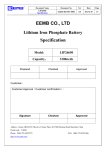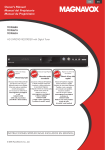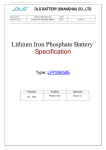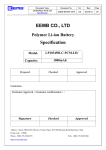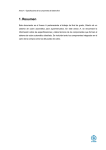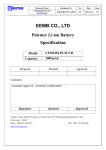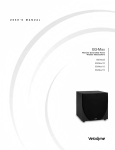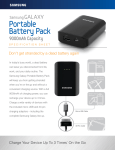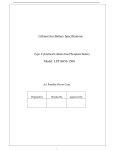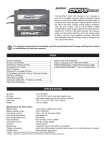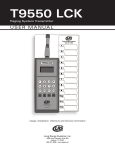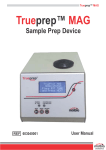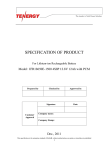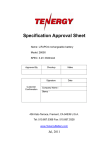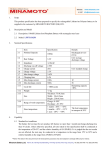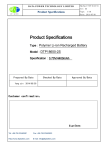Download Specification - BatterySpace
Transcript
Polymer Lithium Ion Battery PL-809797, 9000mAh POLYMER LI-ION BATTERY PRODUCT SPECIFICATIONS Model: PL-809797 Capacity: To: Date: 9000mAh 2007-5-17 Ver. 1.0 Page 1/10 Polymer Lithium Ion Battery PL-809797, 9000mAh History of revisions No 1 Date 2007-05-17 Description The first issue. Ver. 1.0 Page 2/10 Polymer Lithium Ion Battery PL-809797, 9000mAh Contents 1 Scope ………………………………………………………………………………………………………...... 4 2 Product Name and Product Type ...………………………………………………………………................. 2.1 Product Name………………………………………………………………………………………….. 2.2 Product Type…………………………………………………………………………………………… 3 Product Specifications……………………………………………………………………………………….. 1 Nominal Capacity……………………………………………………………………………………… 2 Nominal Voltage.…………………………………………………………………………………….…. 3 Charge Limited Voltage………………………………………………………………………………. 4 Discharge Cut-off Voltage…………………………………………………………………………….. 5 End-of-charge Current……………………………………………………………………………….. 6 Standard Charge………………………………………………………………………………………. 7 Standard Discharge …………………………………………………………………………………… 8 Maximum Continuous Charge Current …………………………………………………………… 9 Maximum Continuous Discharge Current………………………………………………………….. 10 Operating And Storage Temperature Range ………………………………………………………… 11 Operating And Storage Humidity Range……………………………………………………………. 12 Weight…………………………………………………………………………………………………. 4 External Dimension…………………………………………………………………………………………. 5 External Dimension Drawing………………………………………………………………………………... 6 Outside Appearance…………………………………………………………………………………………. 7 Basic Electrical Characteristics…………………………………………………………………………….. 1 Open Circuit Voltage………………………………………………………………………………….. 2 Internal Impedance …………………………………………………………………………………… 3 Rated Capacity (0.2C5A)……………………………………………………………………………… 4 1C5A Capacity…………………………………………………………………………………………. 5 Temperature Characteristics…………………………………………………………………………. 6 Storage Characteristics……………………………………………………………………………….. 7 Cycle Life (20℃) ………………………………………………………………………………………. 4 4 4 4 4 4 4 4 4 4 4 4 4 4 4 4 4 5 6 6 6 6 6 6 6 6 6 8 Safety Characteristics ………………………………………………………………………………… 1 Overcharge Characteristics …………………………………………………………………………... 2 Over-discharge Characteristics....…………………………………………………………………… 3 Short-circuit Characteristics…………………………………………………………………………. 4 Hot Oven Characteristics…………………………………………………………………………….. 5 Impact Test……………………………………………………………………………………………. 6 Crush Test ……………………………………………………………………………………………… 9 Reliability Characteristics …………………………………………………………………………… 1 Static Humidity and Temperature Characteristics………………………………………………….. 2 Vibration Characteristics ……………………………………………………………………………... 3 70℃ Storage Characteristics ………………………………………………………………………… 7 7 7 7 7 7 7 8 8 8 8 10 Protection Function…………………………………………………………………………………………. 11 Guarantee Period of Quality………………………………………………………………………………… 12 Product Responsibility Agreement…………………………………………………………………………. 13 Precaution Before Charging ………………………………………………………………………………... 8 8 8 8 14 Handling precautions on Lithium ion secondary cell ……………………………………………………... 15 Company Information……………………………………………………………………………………….. 9 10 Ver. 1.0 Page 3/10 Polymer Lithium Ion Battery PL-809797, 9000mAh 1. Scope This specification shall be applied to be delivered for Customer’s type. 2. Product Name and Product Type 2.1 Product Name Polymer Li-ion Battery 2.2 Product Type PL-809797 3. Product Specifications No. 1 Item Nominal Capacity Specification 9000mAh 2 Nominal Voltage 3.7V 3 Charge Limited Voltage 4 Discharge Cut-off Voltage 4.20+0.03-0.02V The min is 2.75V, and the standard is 3.0V. End-of-charge Current 180mA Constant Current: (4500mA) 6 Constant Voltage: 4.2V Standard Charge End-of-charge Current: 180mA 7 Standard Discharge Using 0.2C(1800mA) constant current discharge to the Discharge Cut-off Voltage. Standard discharge current: 1C(9000mA) 8 9 10 4500mA 9000mA Maximum Continuous Charge Current Maximum Continuous Discharge Current Charge: Operating Temperature Range Discharge: 4. – 20 ~ 60℃ -20 ~ 60℃ Storage Temperature Range 11 12 0 ~ 45℃ Operating And Storage Humidity Range Weight Less than 85%RH 190.0g or less External Dimension Thickness: Max8.2mm +/- 0.5 mm(Initial 50% charged ,at RT) Width: 97.0±0.5 mm Length: 99.0±0.5mm Ver. 1.0 Page 4/10 Polymer Lithium Ion Battery PL-809797, 9000mAh External Dimension Drawing with tolerance +/- 0.5 mm (Max in mm = Max in mm +/-0.5mm) Negative tab (Ni) Tab insulation Terrace Side formed part Cup part Bottom part 8±1 27±1 5 MAX 96.0 MAX 100.0 MAX 101.5 5. MAX 100.0 MAX 8.6 Ver. 1.0 Page 5/10 Polymer Lithium Ion Battery PL-809797, 9000mAh 6. Outside Appearance It shall be free from any defects such as remarkable scratches, breaks, cracks, discoloration, leakage, or deformation, and it shall be clean. 7. Basic Electrical Characteristics No. Items Criteria 1 Open Circuit Voltage 3.75~3.90V 2 Internal Impedance ≦30mΩ 3 Rated Capacity (0.2C5A) ≧9000mAh 4 0.5C5A Capacity ≧(0.2C5A)*95% Test Conditions Measure cells at 20 ± 5℃ after received Measure cells using an alternate current impedance meter at 1kHz at 20 ± 5℃after received. Standard discharged after the standard charged cells rest 10min at 20 ± 5℃. Three cycles are permitted. Discharged at 0.5C5A rate after the standard charged cells rest 10min at 20 ± 5℃. Three cycles are permitted. Retention Capacity: 5 Temperature Characteristics 60℃≧95%* initial capacity Measured the high rate capacity as the initial capacity. Stored the recharged cells for 3 hrs at 60 ± 0℃≧80% *initial capacity 2℃, 0 ± 2℃,-20 ± 2℃, and then quickly discharged -20℃≧60%* initial capacity at this temperature, but Standard discharged at -20 ± Appearance: No deformation, leakage, ruptures. 2℃ exceptionally. Checked the cells’ appearance Retention Capacity: ≧80% initial capacity Swelling: ≦0.86mm Appearance: No leakage after rest for 2 hrs at room temperature. Measured the high rate capacity as the initial capacity. Stored the recharged cells for 7 days at 60 ± 2℃ and then rest for 2 hrs at room temperature, standard discharged after checked the cells’ appearance and impedance. Retention Capacity: 6 Storage Characteristics Measured the high rate capacity as the initial ≧90% initial capacity capacity. Stored the recharged cells for 30 days at Recoverable Capacity: room temperature. Quickly discharged after checked ≧95% initial capacity the cells’ appearance and impedance. Measured recoverable quickly discharge capacity and Swelling:≦0.86mm Appearance: No leakage, damage recoverable impedance. Stored the recharged cells for 7 days at 60 ± 2℃, Retention Capacity: ≧75% initial capacity relative humility 80~95% , then rest 2hrs at room temperature, Discharged at 1C5A rate after the standard charged cells rest 10min at 20 ± 5℃. Three cycles are permitted. Retention Capacity: 7 Cycle Life (20℃) ≧ 80% initial capacity Swelling:≦0.86mm Carry out 300 cycles (0.2C charge/ 0.5C discharge) at 20± 5℃. Ver. 1.0 Page 6/10 Polymer Lithium Ion Battery PL-809797, 9000mAh 8. Safety Characteristics No. Items 1 Overcharge Characteristics 2 Over-discharge Characteristics 3 Short-circuit Characteristics Criteria The maximum Temperature: Test Conditions Charged the quickly discharged cells at 0.5C (4500mA) ≦150℃ current with a voltage limit of 4.8V. Test can be Appearance: No rupture, fire, terminated until constant voltage charge time is more smoke, nor leakage. than 8 hrs or charge current tapered less than 180mA. The maximum Temperature: Reverse charged the standard charged cells at 0.5C ≦150℃ (4500mA) current to –10V or until the Cell voltage Appearance: No rupture, fire, indicates a positive -△V or discharge-time is more than 2.5 hrs. smoke, nor leakage. The maximum Temperature: 4 Hot Oven Characteristics Rest cells for 30min at 60 ± 2℃ after standard charged. Connect between Cell terminals with 1.5mm2 copper Appearance: No rupture, fire, lead (electric resistance: 50mΩ or less) and leave for 1 hour.. smoke, nor leakage. ≦150℃ The maximum Temperature: ≦200℃ Appearance: No explode 5 Impact Test No fire, explode 6 Crush Test No fire, explode The standard charged cell is to be heated in a gravity convection or circulating air oven. The temperature of the oven is to be raised at a rate of 5±2℃/min. The oven is to remain for 10 minutes at 150±2℃ before the test is discontinued. After standard charged, the cell is to be placed on a flat surface. A 5/8inch (15.8mm) diameter bar is to be placed across the center of the sample. A 20 pound (9.1kg) weight is to be dropped from a height of 24±1 inch (610±25mm) onto the sample. After standard charged, the cell is to be crushed between two flat surfaces. The force for the crushing is to be applied by a hydraulic ram with a 1.25inch (32mm) diameter piston. The crushing is to be continue until a pressure reading of 2500 psig (17.2MPa) is reached on the hydraulic ram, applied force of 3000 pounds(13kN). Once the maximum pressure has been obtained it is to be released. Ver. 1.0 Page 7/10 Polymer Lithium Ion Battery PL-809797, 9000mAh 9. Reliability Characteristics No. Items Criteria Test Conditions Measured the high rate capacity as the initial capacity. Stored the recharged cells for 4 days at Retention Capacity: 1 Static Humidity and Temperature Characteristics ≧50% initial capacity 60 ± 2℃ and 95%RH, Recoverable Capacity: ≧80% initial capacity Swelling: ≦0.86mm Appearance: No leakage, damage 2 3 Vibration Characteristics 70℃ Storage Characteristics then rest for 4 hrs at room temperature. Quickly discharged after checked the cells’ appearance and impedance. Measured recoverable quickly discharge capacity and recoverable impedance. Measured the initial OCV and impedance after standard charged at 20±5℃. Vibrate the cells for 30minutes on each direction at room temperature in 10min. Recovery capacity: ≧90% Amplitude: 1.6mm, (p-p) Appearance: No deformation, leakage Vibration: 10-60Hz (sweep 1 oct/min) Direction: X, Y, Z Then measure OCV and impedance. Measured the high rate capacity as the initial capacity. Stored the recharged cells for 48 hrs at Recoverable Capacity: 70 ± 2℃, then rest for 2 hrs at room ≧30% initial capacity temperature. Quickly discharged after checked Swelling:≦0.86mm the cells’ appearance and impedance. Measured Appearance: No leakage, damage recoverable quickly discharge capacity and recoverable impedance. OCV Variation: ≦0.01V 10. Protection Function If a Polymer Li-ion Battery is subjected to a voltage higher than the allowable voltage or is charged with an excessive current, the electrolyte may decompose, resulting possibly in degassing or compromising cell safety. If cell voltage decreases below 1.0V approx., cell performance may deteriorate. Therefore, must be equipped protection circuit that can prevent overcharge, over-discharge, and over-current. 11. Guarantee Period of Quality Guarantee period of quality is 3 months after sold. 12. Product Responsibility Agreement Using cells must be observed Product Specification and remarks of AA Portable Power Corp. Because misuse may cause cell heat, fire or explosive, LC will not be responsible for any accident occurred by handling outside of the precautions in this specification. 13. Precaution Before Charging Any information will be notified to consumer with data of quality and reliability while specification, materials, product process or control system will be changed. Ver. 1.0 Page 8/10 Polymer Lithium Ion Battery PL-809797, 9000mAh 14. Handling precautions on Lithium ion secondary cell To assure product safety, describe the following precautions in the instruction manual of the equipment. ! Danger - When charging the Cell, use dedicated chargers and follow the specified conditions. Use the Cell only in the specified equipment. Do not connect Cell directly to an electric outlet or cigarette lighter charger. Do not heat or throw Cell into a fire. - Do not use, leave Cell close to fire or inside of a car where temperature may be above 60℃. Also do not - charge / discharge in such conditions. Do not immerse, throw, and wet Cell in water/ seawater Do not put batteries in your pockets or a bag together with metal objects such as necklaces. Hairpins, coins, or screws. Do not store batteries with such objects. Do not short circuit the (+) and (-) terminals with other metals. Do not place Cell in a device with the (+) and (-) in the wrong way around. Do not pierce Cell with a sharp object such as a needle. Do not hit with a hammer, step on or throw or drop to cause strong shock. Do not disassemble or modify the Cell. Do not solder a Cell directly. Do not use a Cell with serious scar or deformation. Thoroughly read the user’s manual before use, inaccurate handling of lithium ion rechargeable Cell may cause leakage, heat, smoke, an explosion, or fire ! Warning - Do not put Cell into a microware oven, dryer, or high-pressure container. Do not use Cell with dry cells and other primary batteries, or batteries of a different package, type, or brand. Stop charging the Cell if charging is not completed within the specified time. Stop using the Cell if abnormal heat, odor, discoloration, deformation or abnormal condition is detected during use, charge, or storage. Keep away from fire immediately when leakage or foul odor is detected. If liquid leaks onto your skin or clothes, wash well with fresh water immediately. If liquid leaking from the Cell gets into your eyes, do not rub your eyes. Wash them well with clean water and go to see a doctor immediately. ! Caution - Store batteries out of reach of children so that they are not accidentally swallowed. If younger children use the Cell, their guardians should explain the proper handling. Before using the Cell, be sure to read the user’s manual and cautions on handling thoroughly. Thoroughly read the user’s manual for the charger before charging the Cell. For information on installing and removing from equipment, thoroughly read the user’s manual for the specific equipment. Batteries have life cycles. If the time that the Cell powers equipment becomes much shorter than usual, the Cell life is at an end. Replace the Cell with a new same one. Ver. 1.0 Page 9/10 Polymer Lithium Ion Battery PL-809797, 9000mAh - Remove a Cell whose life cycle has expired from equipment immediately. When not using Cell for an extended period, remove it from the equipment and store in a place with low humidity and low temperature. While the Cell pack is charged, used and stored, keep it away from objects or materials with static electric charges. If the terminals of the Cell become dirty, wipe with a dry clothe before using the Cell. The Cell can be used within the following temperature ranges. Do not exceed these ranges. Charge temperature range : 0℃ to 45℃ Discharge temperature range : -20℃ to 60℃ (When using equipment) Ver. 1.0 Page 10/10











